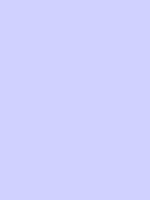#d1d1ff Color Information
In a RGB color space, hex #d1d1ff is composed of 82% red, 82% green and 100% blue. Whereas in a CMYK color space, it is composed of 18% cyan, 18% magenta, 0% yellow and 0% black. It has a hue angle of 240 degrees, a saturation of 100% and a lightness of 91%. #d1d1ff color hex could be obtained by blending #ffffff with #a3a3ff. Closest websafe color is: #ccccff.
-
- R 82
- G 82
- B 100
-
- C 18
- M 18
- Y 0
- K 0
● #d1d1ff color description : Very pale blue.
#d1d1ff Color Conversion
The hexadecimal color #d1d1ff has RGB values of R:209, G:209, B:255 and CMYK values of C:0.18, M:0.18, Y:0, K:0. Its decimal value is 13750783.
| Hex triplet | d1d1ff | #d1d1ff |
|---|---|---|
| RGB Decimal | 209, 209, 255 | rgb(209,209,255) |
| RGB Percent | 82, 82, 100 | rgb(82%,82%,100%) |
| CMYK | 18, 18, 0, 0 | |
| HSL | 240°, 100, 91 | hsl(240,100%,91%) |
| HSV (or HSB) | 240°, 18, 100 | |
| Web Safe | ccccff | #ccccff |
| CIE-LAB | 85.188, 9.148, -22.425 |
|---|---|
| XYZ | 67.142, 66.376, 103.877 |
| xyY | 0.283, 0.28, 66.376 |
| CIE-LCH | 85.188, 24.219, 292.192 |
| CIE-LUV | 85.188, -2.696, -37.309 |
| Hunter-Lab | 81.471, 4.529, -18.565 |
| Binary | 11010001, 11010001, 11111111 |
Color Schemes with #d1d1ff
Alternatives to #d1d1ff
Below, you can see some colors close to #d1d1ff. Having a set of related colors can be useful if you need an inspirational alternative to your original color choice.
#d1d1ff Preview
This text has a font color of #d1d1ff.
<span style="color:#d1d1ff;">Text here</span>This paragraph has a background color of #d1d1ff.
<p style="background-color:#d1d1ff;">Content here</p>This element has a border color of #d1d1ff.
<div style="border:1px solid #d1d1ff;">Content here</div>.text {color:#d1d1ff;}.background {background-color:#d1d1ff;}.border {border:1px solid #d1d1ff;}Shades and Tints of #d1d1ff
A shade is achieved by adding black to any pure hue, while a tint is created by mixing white to any pure color. In this example, #00000d is the darkest color, while #f8f8ff is the lightest one.
-
#00000d
#00000drgb(0,0,13) -
#000020
#000020rgb(0,0,32) -
#000034
#000034rgb(0,0,52) -
#000048
#000048rgb(0,0,72) -
#00005b
#00005brgb(0,0,91) -
#00006f
#00006frgb(0,0,111) -
#000083
#000083rgb(0,0,131) -
#000096
#000096rgb(0,0,150) -
#0000aa
#0000aargb(0,0,170) -
#0000bd
#0000bdrgb(0,0,189) -
#0000d1
#0000d1rgb(0,0,209) -
#0000e5
#0000e5rgb(0,0,229) -
#0000f8
#0000f8rgb(0,0,248)
-
#0d0dff
#0d0dffrgb(13,13,255) -
#2020ff
#2020ffrgb(32,32,255) -
#3434ff
#3434ffrgb(52,52,255) -
#4848ff
#4848ffrgb(72,72,255) -
#5b5bff
#5b5bffrgb(91,91,255) -
#6f6fff
#6f6fffrgb(111,111,255) -
#8383ff
#8383ffrgb(131,131,255) -
#9696ff
#9696ffrgb(150,150,255) -
#aaaaff
#aaaaffrgb(170,170,255) -
#bdbdff
#bdbdffrgb(189,189,255) -
#d1d1ff
#d1d1ffrgb(209,209,255) -
#e5e5ff
#e5e5ffrgb(229,229,255) -
#f8f8ff
#f8f8ffrgb(248,248,255)
Tones of #d1d1ff
A tone is produced by adding gray to any pure hue. In this case, #e6e6ea is the less saturated color, while #d1d1ff is the most saturated one.
-
#e6e6ea
#e6e6eargb(230,230,234) -
#e4e4ec
#e4e4ecrgb(228,228,236) -
#e3e3ed
#e3e3edrgb(227,227,237) -
#e1e1ef
#e1e1efrgb(225,225,239) -
#dfdff1
#dfdff1rgb(223,223,241) -
#ddddf3
#ddddf3rgb(221,221,243) -
#dcdcf4
#dcdcf4rgb(220,220,244) -
#dadaf6
#dadaf6rgb(218,218,246) -
#d8d8f8
#d8d8f8rgb(216,216,248) -
#d6d6fa
#d6d6fargb(214,214,250) -
#d5d5fb
#d5d5fbrgb(213,213,251) -
#d3d3fd
#d3d3fdrgb(211,211,253) -
#d1d1ff
#d1d1ffrgb(209,209,255)
Color Blindness Simulator
Below, you can see how #d1d1ff is perceived by people affected by a color vision deficiency. This can be useful if you need to ensure your color combinations are accessible to color-blind users.
